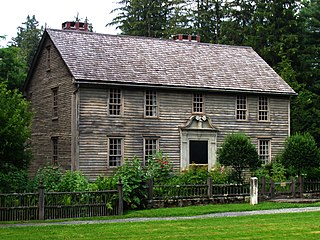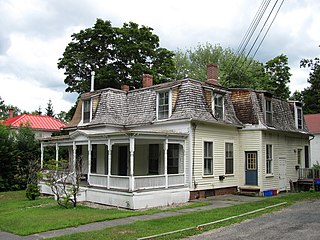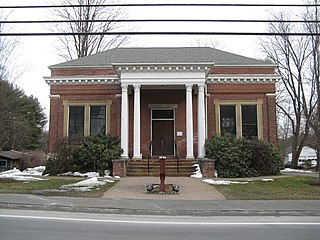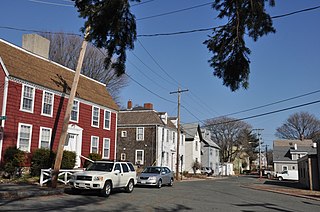
The Mission House is an historic house located at 19 Main Street, Stockbridge, Massachusetts. It was built between 1741 and 1742 by a Christian missionary to the local Mahicans. It is a National Historic Landmark, designated in 1968 as a rare surviving example of a colonial mission house. It is now owned and operated as a nonprofit museum by the Trustees of Reservations.

The Building at 10 Follen Street is a historic house at 10 Follen Street in Cambridge, Massachusetts. The three-story wood-frame house was designed by Peabody & Stearns and built in 1875. It is a rare well-preserved example of the transition between Second Empire and Stick styles, with a truncated hip roof, a highly decorated porch, and most of its original interior woodwork.

The Harlow Old Fort House is a First Period historic house at 119 Sandwich Street in Plymouth, Massachusetts.

The William Street Historic District is a historic district in Vineyard Haven, Massachusetts, on the island of Martha's Vineyard. The district includes houses on William Street from Woodlawn Avenue in the north to several houses south of Camp Street. It represents the single best preserved area of mid 19th century houses in Vineyard Haven.

The George Clapp House is a historic house at 44 North Street in Grafton, Massachusetts. Built about 1835, it is the town's only significant example of high-style Greek Revival architecture, with temple treatment on both the front and one side. The house was listed on the National Register of Historic Places on August 21, 1997.

The Building at 8–22 Graves Avenue is a historic rowhouse just outside the downtown area of Northampton, Massachusetts. The Queen Anne style brick rowhouse was built in 1887 for Doctor Silas R. Cooley. The property is unusual because brick was not then a common building material for housing in the Connecticut River valley, and because the rowhouse style of construction was also rare in the area. The building was listed on the National Register of Historic Places in 1985.

The Calvin Coolidge House is a historic house located at 19-21 Massasoit Street in Northampton, Massachusetts. Built in 1901, it is most historically significant as the home of the 30th president of the United States, Calvin Coolidge between 1906 and 1930, the height of his political career. It was listed on the National Register of Historic Places on December 12, 1976.

The East Village Historic District is a historic district encompassing the center of the East Village of Amherst, Massachusetts, United States. It includes properties on Main Street, North East Street, and South East Street. The village was one of Amherst's principal civic and commercial centers until the arrival of the railroad in Amherst Center in 1853, and remained a primarily residential area thereafter. The district was listed on the National Register of Historic Places in 1986.

The Williamsburg Center Historic District is a historic district on Massachusetts Route 9 in Williamsburg, Massachusetts. It encompasses the traditional center of the town, which was settled in the 18th century and grew to prosperity in the mid-19th century. It was listed on the National Register of Historic Places in 1980.

The Main Street Historic District of Easthampton, Massachusetts encompasses the historic heart of the town, running along Main Street between Northampton and Center Streets. The area has been the civic and economic heart of the town since incorporation in 1785. Most of the commercial buildings date from the 1840s to the 1880s, and are built in an Italianate style. The housing stock of the district also includes Italianate styling, but there are also a number of Greek Revival structures. The major civic structures of the town are in the district, including the town hall, public library, and the First Congregational Church, which is the second for the congregation, a brick Romanesque Revival building dating to 1851. The district was added to the National Register of Historic Places in 1986.

The Prospect—Gaylord Historic District is a historic district encompassing a residential area built up mostly in the late 19th century just outside the central business district of Amherst, Massachusetts. Contributing properties include most of the houses on Prospect Street, which parallels Pleasant Street, as well as properties on Gaylord and Amity Streets running west from Prospect. These houses are generally in late Victorian styles such as Queen Anne, although some, for example a workman's house at 24 Gaylord Street, are in a more vernacular style. A central element of the district is the Hope Community Church, a historically African American church built in 1912 for a congregation whose history dates to 1869. Funds for its construction were raised in part through the efforts of W.E.B. Du Bois. The district was listed on the National Register of Historic Places in 1993.

The Southampton Center Historic District encompasses the densely built center of the otherwise predominantly rural town of Southampton, Massachusetts. The district extends from Fomer Road in the south, along High Street and College Highway to Maple Street, and includes a line of houses along East Street from College to Elm. This area is the historic heart of the town, being first laid out in the 1730s. The district includes, in addition to a number of 18th- and 19th-century residences, the town's only church, the town hall, and the old public library. The district was listed on the National Register of Historic Places in 1991.

The Fish Flake Hill Historic District encompasses a section of Front Street in Beverly, Massachusetts that includes a remarkable concentration of colonial buildings, and which was notable for its importance in the American Revolutionary War. The district, which was listed on the National Register of Historic Places in 1971, includes properties on both sides of Front Street between Cabot and Bartlett Streets. It includes houses dating to the middle 18th century, sixteen of which have been documented as being associated with ship captains active in the American Revolutionary War. The port area of Beverly was one of the most active during the war, and was one of the places where many captured ships were brought.

The Marblehead Historic District is a 2,300-acre (930 ha) historic district roughly bounded by Marblehead Harbor, Waldron Court, Essex, Elm, Pond, and Norman Streets in Marblehead, Massachusetts. Among its notable features are Fort Sewall, a coastal fortification with origins dating to 1644, and two National Historic Landmarks, the General John Glover House, the Jeremiah Lee Mansion, and the Simon Bradstreet House.

The Adams-Magoun House is a historic house at 438 Broadway in Somerville, Massachusetts. Built about 1783, it is one of the city's few surviving 18th-century buildings and its best-preserved. It was listed on the National Register of Historic Places in 1989.

The Call-Bartlett House is a historic house in Arlington, Massachusetts. Built in 1855, it is one of the town's finest examples of Greek Revival architecture. The house was listed on the National Register of Historic Places in 1985.

The Cushman House is a historic house in Arlington, Massachusetts. Built in the mid-1880s and moved to its present location in 1896, it is a well-preserved but fully realized example of Queen Anne architecture. It was listed on the National Register of Historic Places in 1985.

The Elisha KnightHomestead is a historic house at 170 Franklin Street in Stoneham, Massachusetts. Built c. 1750, it is the only property of that period in Stoneham that retains a rural setting. The two-story wood-frame house has relatively modest decorations; its decorated entry hood dates to a c. 1870 renovation that probably also removed a central chimney, replacing it with one at the east end.

The Twinehurst American Optical Company Neighborhood is a residential historic district in Southbridge, Massachusetts. It consists of seven three family houses built by the owners of the American Optical Company to provide housing for their workers. The district was listed on the National Register of Historic Places in 1989.
The Walnut Park Historic District is a historic district encompassing a cluster of multifamily brick buildings in the Roxbury neighborhood of Boston, Massachusetts. Roughly centered on the junction of Walnut Park and Waldren Road, the area was developed in the early 20th century during a major Jewish migration, and includes a fine sample of Colonial Revival architecture. The district was listed on the National Register of Historic Places in 2022.






















